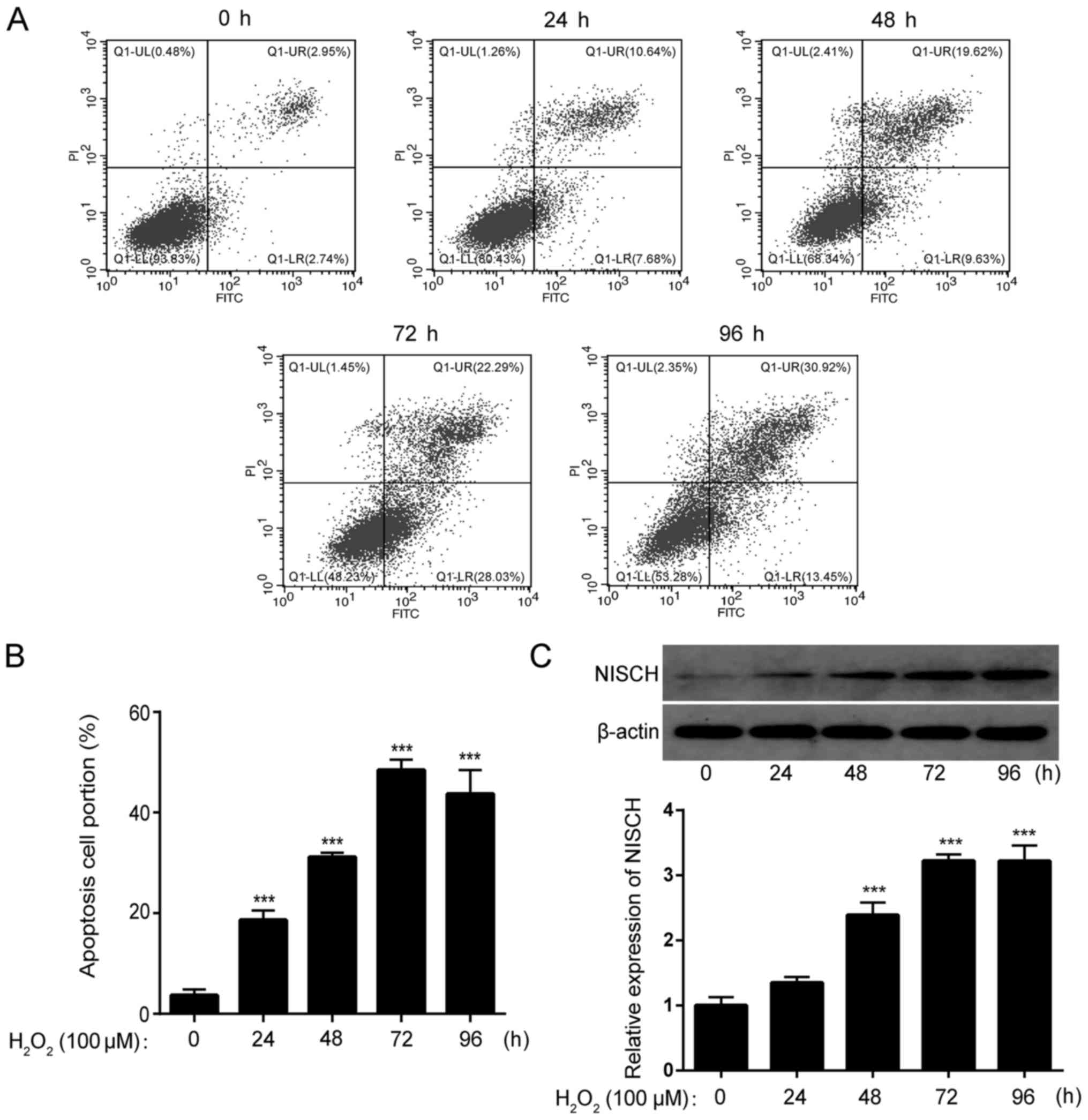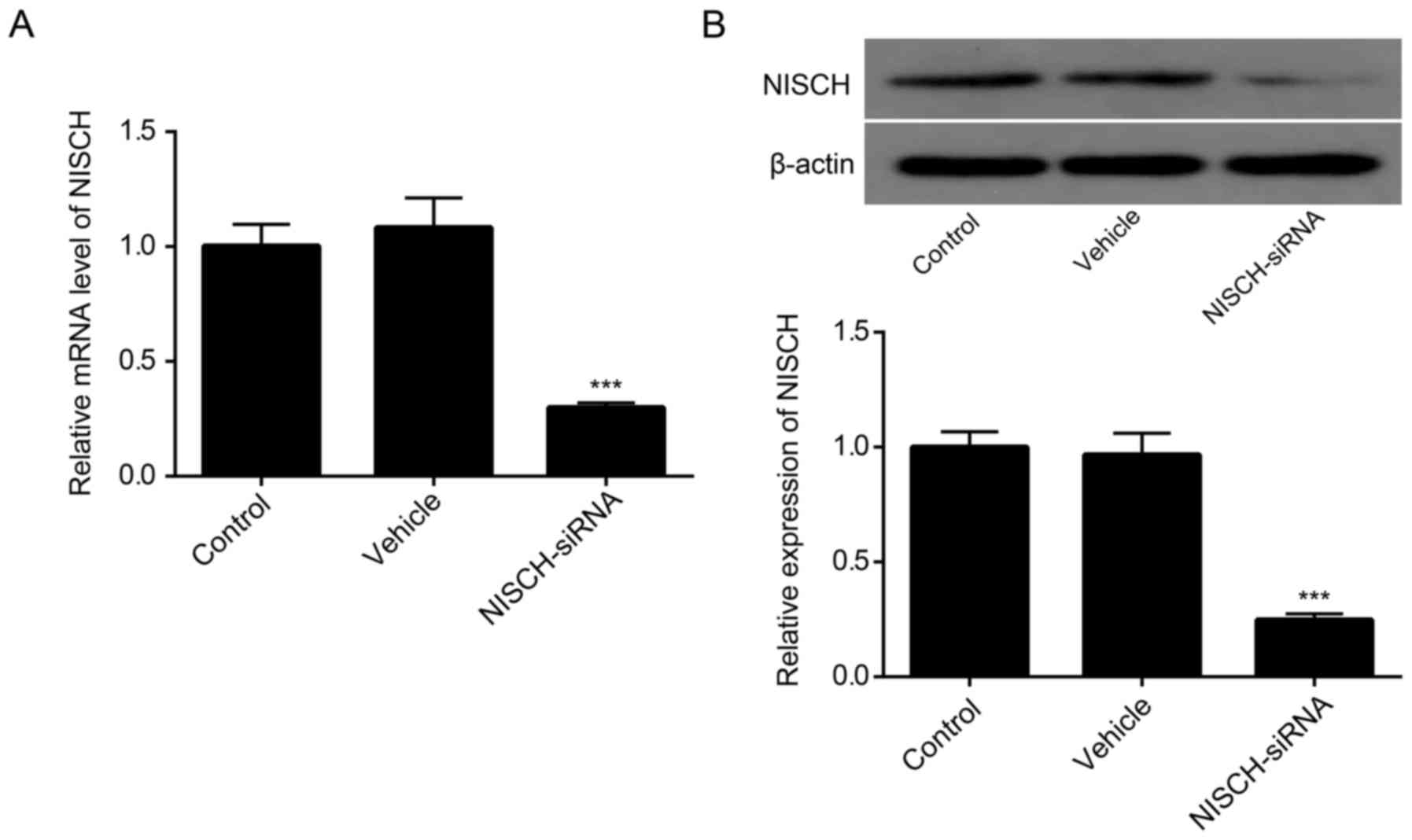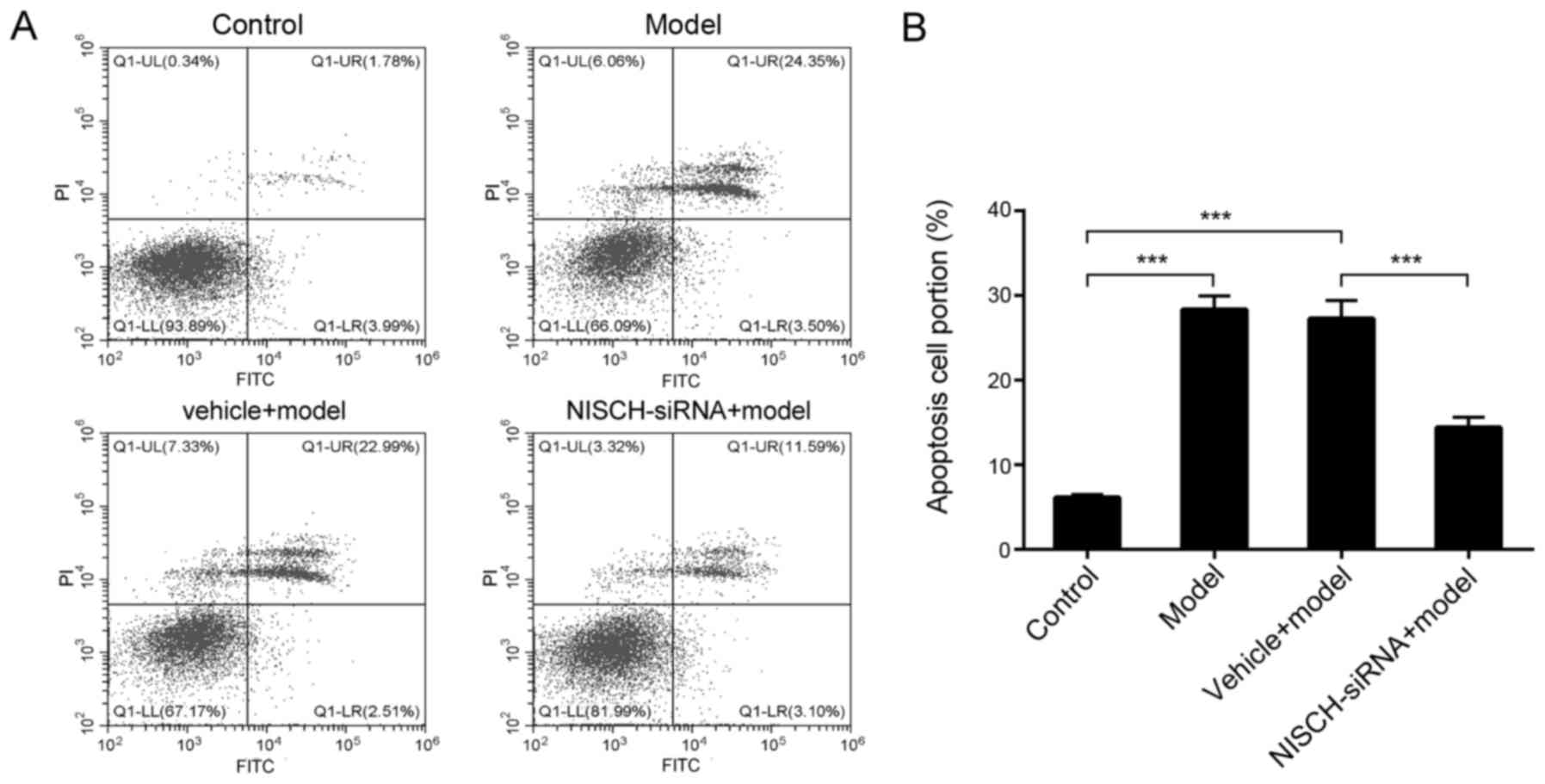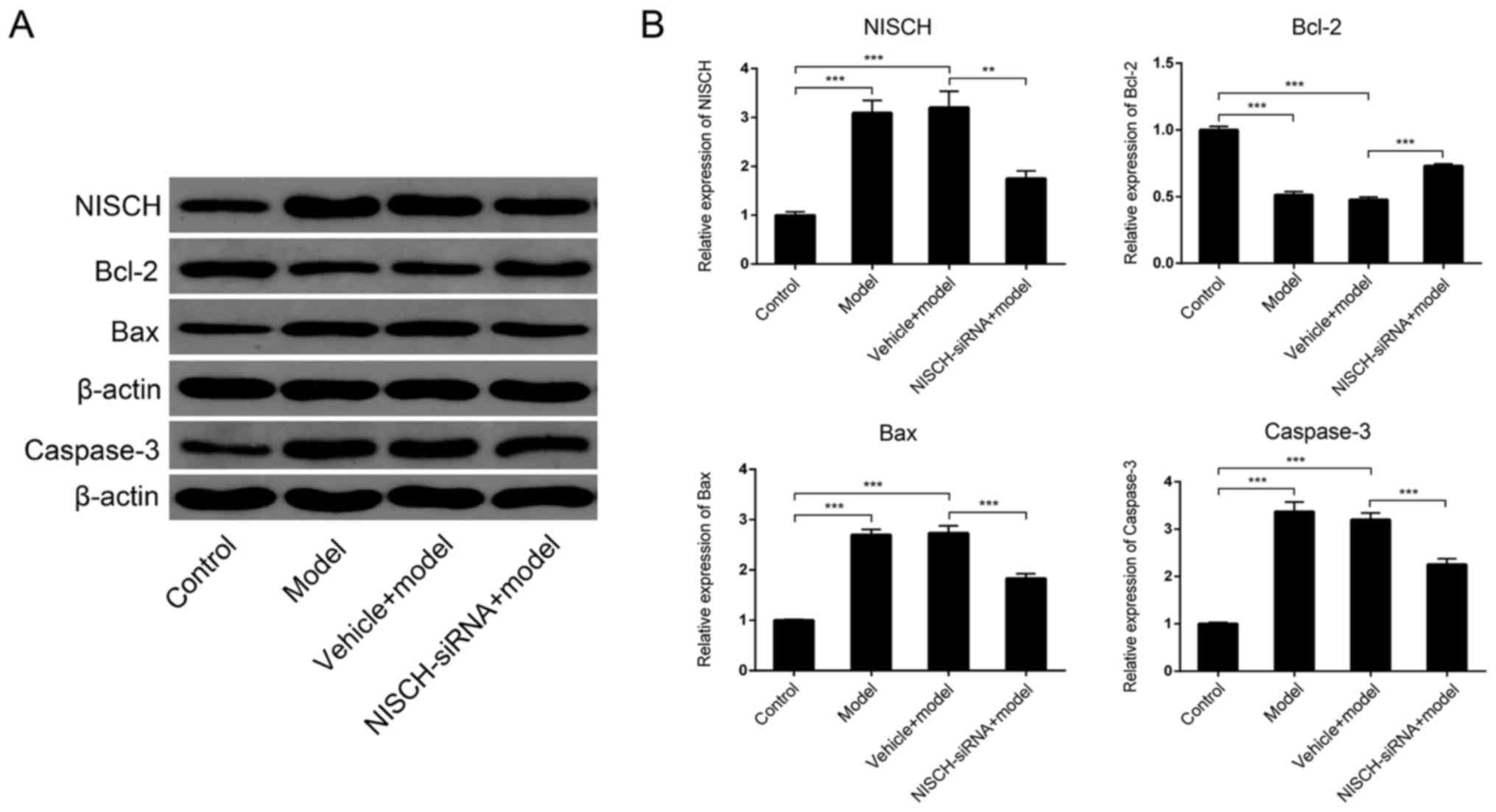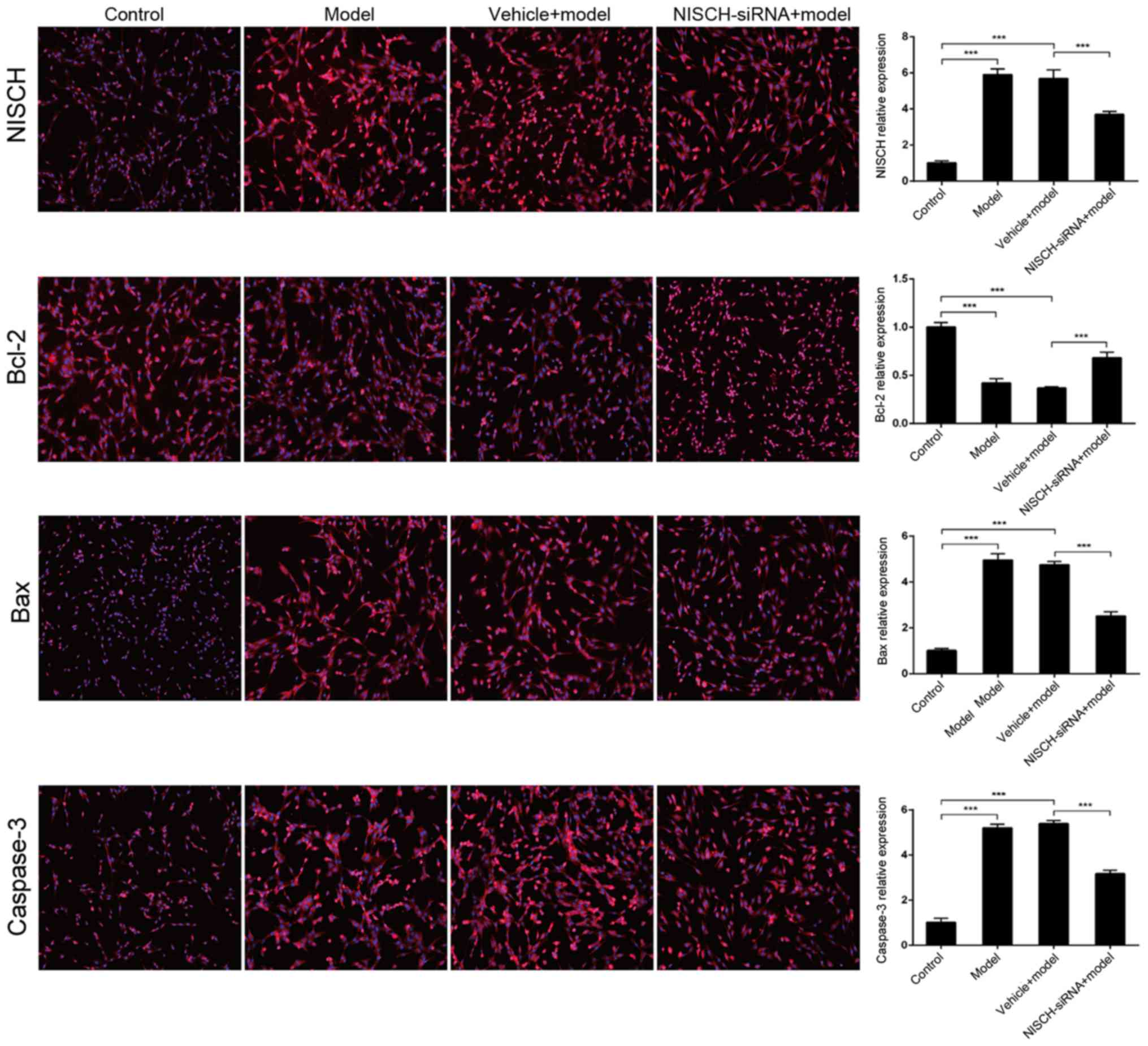Nischarin attenuates apoptosis induced by oxidative stress in PC12 cells
- Authors:
- Published online on: November 27, 2018 https://doi.org/10.3892/etm.2018.7017
- Pages: 663-670
-
Copyright: © Guo et al. This is an open access article distributed under the terms of Creative Commons Attribution License.
Abstract
Introduction
Spinal cord injury (SCI) occurs as a result of a multifactorial process, involving primary injury subsequently followed by a secondary injury (1). Primary injury, caused by an initial physical impact, is characterized by acute bleeding and ischemia (2). Secondary injury may be induced by several mechanisms, including inflammation, oxidative stress, ion balance dysregulation and excitotoxicity (3–5). It has been reported that allicin may protect rats against SCI via regulation of oxidative stress and inflammatory response pathways (6), while inhibition of reactive oxygen species (ROS) production may improve outcomes following SCI by mediating acute reductions in oxidative stress and inflammation (7). Apoptosis has been suggested as a potential therapeutic target for secondary SCI (8), as one of the most damaging processes of secondary SCI is neuronal apoptosis (9). Motor neuron apoptosis is the main cause of dysfunction following SCI, as it is one of the primary obstacles for locomotor functional recovery (10).
The generation of ROS, such as superoxide anions, H2O2 and hydroxyl radicals, is a normative response to disease or injury, including SCI (11). The increased formation of ROS may exceed the capacity of the antioxidant defense systems and subsequently lead to oxidative stress (12,13). Oxidative stress serves an important role in apoptosis induction under physiologic and pathologic conditions (14,15). A previous study demonstrated that myricetin may protect cells against H2O2-induced cell damage via its anti-apoptotic effects (16).
Nischarin (NISCH) is a cytosolic protein that is found anchored to the inner layer of the plasma membrane, and has been demonstrated to interact with cytosolic and intermembrane proteins (17). NISCH is expressed in various organs, and a previous study demonstrated that NISCH serves an inhibitory role in cell migration, invasion and the carcinogenesis of breast cancer cells (18). NISCH is highly expressed in the brain of adult rats, and has been confirmed to be expressed in PC12 and Neuro-2A cell lines (19). It has been reported that overexpression of NISCH may induce human breast cancer apoptosis and inhibit cell migration and invasion (20), while inhibition of NISCH expression promotes neurite outgrowth (18). Recently, it has been shown that NISCH downregulation by small-interfering RNA (siRNA) accelerates rat motor function recovery following SCI (21), indicating that NISCH may be involved in the pathological mechanisms of SCI. However, the exact molecular mechanism remains unclear.
The authors of the present study hypothesized that NISCH downregulation attenuates oxidative stress-induced apoptosis in PC12 cells. Therefore, the apoptotic rate of PC12 cells and the expression of Bcl-2/Bcl-2-associated X (Bax) signaling pathway members was examined in the present study.
Materials and methods
Cell culture
The PC12 rat pheochromocytoma tumor cell line was purchased from PeproTech Inc. (Rocky Hill, NJ, USA) and maintained in RPMI 1640 medium supplemented with 10% heat-inactivated fetal bovine serum (both Gibco; Thermo Fisher Scientific, Inc., Waltham, MA, USA) and 100 U/ml penicillin and 100 µg/ml streptomycin (Thermo Fisher Scientific, Inc.) at 37°C in a humidified atmosphere containing 5% CO2.
Flow cytometric analysis of cell apoptosis
Cells were treated with 100 µM H2O2 for 0, 24, 48, 72 and 96 h. Following H2O2 treatment, cells were harvested by trypsinization and washed twice with cold phosphate-buffered saline (PBS). Cell apoptosis was measured following drug treatment using the Annexin V-FITC/PI Apoptosis Detection kit (Nanjing KeyGen Biotech Co., Ltd., Nanjing, China) according to the manufacturer's instructions. Cells were resuspended and mixed with 500 µl binding buffer containing 5 µl Annexin V-fluorescein isothiocyanate (FITC) and 5 µl propidium iodide (PI). Following incubation for 15 min at room temperature in the dark, cell apoptosis was detected using fluorescence-activated cell sorting (FACS) flow cytometers from BD Biosciences (Franklin Lakes, NJ, USA) or Beckman Coulter, Inc. (Brea, CA, USA) using BD Cell Quest research software (version 5.2.1; BD Biosciences).
NISCH siRNA preparation and cell transfection
The NISCH siRNA and negative control sequences were as follows: NISCH siRNA sense, 5′-GCAAGCACUGACCACUCUATT-3′ and anti-sense, 5′-UAGAGUGGUCAGUGCUUGCTT-3′; Negative control sense, 5′-UUCUCCGAACGUGUCACGUTT-3′, and anti-sense, 5′-ACGUGACACGUUCGGAGAATT-3′. NISCH siRNA was diluted to 20 µM with a universal buffer (Beijing Huaxia Ocean Technology Co., Ltd., Beijing, China). Cells were divided into control, vehicle and NISCH-siRNA groups. PC12 cells in the logarithmic growth phase were seeded at a density of 2.5×105 cells/well in a 12-well plate (1 ml/well) and incubated at 37°C and 5% CO2 overnight. At 2 h prior to transfection, the culture medium was replaced with serum-free RPMI-1640 culture medium. To prepare cells for transfection, 5 µl siRNA was first diluted in 200 µl Opti-MEM (Gibco; Thermo Fisher Scientific, Inc.) without serum. Lipofectamine™ 2000 (Invitrogen; Thermo Fisher Scientific, Inc.) was gently mixed with the diluted siRNA solution (total volume 400 µl) and the samples were incubated at room temperature for 20 min. A total of 200 µl of this mixture was added into each well, and the cell culture plate was gently shaken to mix the culture solution. The transfection groups were as follows: Control group, no transfection; vehicle group, transfected with negative control sequences; NISCH-siRNA group, transfected with siRNA sequences targeting the rat NISCH gene.
Reverse transcription-quantitative polymerase chain reaction (RT-qPCR)
Total RNA was isolated using a TRIzol reagent kit (Aidlab Biotechnologies Co., Ltd., Beijing, China) and reverse transcribed into cDNA using the HiScript® Reverse Transcriptase (RNase H) kit (Vazyme, Piscataway, NJ, USA), according to the manufacturer's protocol. Real-time PCR was performed using the 7900HT Real-Time PCR System (Applied Biosystems; Thermo Fisher Scientific, Inc.), according to manufacturer's protocol. The mRNA expression levels of NISCH were normalized to the endogenous expression of β-actin. Primers were purchased from Tsingke (Beijing, China). The following primer pairs were used for qPCR analyses: NISCH, forward, 5′-TATGTTGTGGCACAGAAGATGG-3′ and reverse, 5′-TTCAGGCAATGGATAGTGGAT-3′; β-actin forward, 5′-CACGATGGAGGGGCCGGACTCATC-3′ and reverse, 5′-TAAAGACCTCTATGCCAACACAGT-3′. The PCR reaction was performed in a total volume of 20 µl, consisting of 4 µl cDNA (5 ng/µl), 0.8 µl primer mix (10 µM), 10 µl SYBR-Green PCR Master Mix (Vazyme Biotech Co., Ltd.), 0.4 µl ROX Reference Dye 2 (50X; ShenZhen Hui Nuo Biotechnology Co., Ltd., Shenzhen, China) and 4.8 µl H2O. Thermal cycling conditions were as follows: 95°C for 15 min, followed by 40 cycles at 95°C for 15 sec, and 60°C for 1 min. β-actin was used as an internal control and the expression levels of target genes were calculated using the 2−ΔΔCq method (22).
Western blot analysis
Total protein was extracted from H2O2-treated cells using lysis buffer (Beyotime Institute of Biotechnology, Shanghai, China) and the samples were incubated on ice for 50 min. Protein concentration was measured using a bicinchoninic acid assay kit (Beyotime Institute of Biotechnology). An equal quantity of protein for each sample was separated via SDS-PAGE on a 12% gel and then transferred to a polyvinylidene difluoride membrane (EMD Millipore, Billerica, MA, USA). The membrane was blocked with 10% skim milk in PBS and 0.1% Tween-20 (pH 7.2) for 2 h at room temperature and incubated at 4°C overnight with an appropriate quantity of the following primary antibodies: Mouse monoclonal anti-β-actin (dilution, 1:200; cat. no. BM0627; Wuhan Boster Biological Technology, Ltd., Wuhan China), mouse polyclonal anti-NISCH (dilution, 1:500; cat. no. 558262; BD Biosciences), rabbit polyclonal anti-Bcl-2 (dilution, 1:500; cat. no. 12789-1-AP; Wuhan Sanying Biotechnology, Wuhan, China), rabbit polyclonal anti-Bax (dilution, 1:5,000; cat. no. ab32503; Abcam, Cambridge, UK) and rabbit polyclonal anti-caspase-3 (dilution, 1:800; cat. no. 19677-1-AP; Wuhan Sanying Biotechnology). Immunoblots were incubated with the horseradish peroxidase-labeled secondary antibodies goat anti-rabbit Ig (dilution, 1:50,000; cat. no. BA1054) or goat anti-mouse Ig (dilution, 1:50,000, cat. no. BA1051; both Wuhan Boster Biological Technology, Ltd.) for 2 h at 21°C, and bands were detected using the Novex™ ECL Chemiluminescent Substrate Reagent kit (Thermo Fisher Scientific, Inc.). Densitometry analysis was performed using ImageJ software (version 1.48u; National Institutes of Health, Bethesda, MD, USA).
Immunofluorescence analysis
Cells mounted on slides were placed in a culture plate and washed with PBS three times. The cells were then fixed with 4% paraformaldehyde for 15 min at 4°C and incubated with 0.5% Triton X-100 at room temperature for 20 min. Subsequently, cells were blocked with 5–10% goat serum (Wuhan Boster Biological Technology, Ltd.) at room temperature for 30 min. Cells were subsequently incubated overnight at 4°C with primary antibodies against NISCH (dilution, 1:50; cat. no. 558262; BD Biosciences), Bcl-2 (dilution, 1:50; cat. no. 12789-1-AP; Wuhan Sanying Biotechnology), Bax (dilution, 1:250; cat. no. ab32503; Abcam) and caspase-3 (dilution, 1:50, cat. no. 19677-1-AP; Wuhan Sanying Biotechnology). Immunofluorescence was generated by incubating samples with the Cy3-conjugated secondary antibodies goat anti-rabbit IgG (dilution, 1:100; cat. no. BA1032) or goat anti-mouse IgG (1:100; cat. no. BA1031; both Wuhan Boster Biological Technology, Ltd.) for 1 h at 37°C in the dark. DAPI (5 µg/ml) was added to counterstain the nuclei, and the slides were incubated for 5 min at room temperature in the dark before being washed with PBS to remove excess DAPI. Images were obtained using a fluorescence microscope (Olympus BX53; Olympus Corporation, Tokyo, Japan).
Statistical analysis
Statistical analysis was performed using GraphPad 6.0 software (GraphPad Software, Inc., La Jolla, CA, USA). The data are expressed as the mean ± standard error of the mean and are representative of three independent experiments. Comparisons among multiple groups were performed by one-way analysis of variance followed by a Bonferroni post hoc multiple comparison test. P<0.05 was considered to indicate a statistically significant difference.
Results
H2O2-induces cell apoptosis and increases NISCH expression in PC12 cells
Cells were treated with 100 µM H2O2 for 0, 24, 48, 72 and 96 h, respectively. By staining cells with Annexin V-FITC and PI, the apoptotic rate was analyzed by FACS. The results demonstrated that the proportion of apoptotic cells was significantly increased by H2O2 treatment of PC12 cells at all time points (Fig. 1A and B). Furthermore, the expression of NISCH in PC12 cells was significantly increased by H2O2 treatment in a time-dependent manner (Fig. 1C).
NISCH-siRNA reduces NISCH expression in PC12 cells
As demonstrated in Fig. 2A, the level of NISCH mRNA was significantly decreased in PC12 cells at 48 h following transfection with NISCH-siRNA. Consistent with these results, western blot analysis indicated that the expression of NISCH was reduced in PC12 cells at 48 h following NISCH-siRNA transfection (Fig. 2B).
NISCH downregulation attenuates H2O2-induced apoptosis in PC12 cells
As demonstrated in Fig. 3A and B, H2O2 significantly increased the level of apoptosis in PC12 cells, while NISCH downregulation significantly reduced apoptosis levels at 48 h following H2O2 treatment. These results suggested that NISCH may function as a pro-apoptotic protein during H2O2-induced apoptosis, and downregulation of NISCH may serve a protective role in H2O2-treated PC12 cells.
NISCH downregulation alters Bcl-2/Bax signaling induced by H2O2 in PC12 cells
The Bcl-2/Bax signaling pathway serves an important role in apoptosis (23). The pro-survival Bcl-2 and pro-apoptotic Bax are the two most extensively studied members of the Bcl-2 family. These proteins function as the primary regulators of the mitochondrial apoptosis signaling pathway (24). Caspase enzymes are crucial effectors of the cell death signaling pathway and are activated by almost all apoptosis-inducing stimuli within neurons and non-neuronal cells (25). Caspase-3 appears to serve a pivotal role in this pathway and has been demonstrated to be necessary for the regulation of development-associated cell death in the brain (25). Therefore, the expression of Bcl-2 and Bax in PC12 cells at 48 h following H2O2 treatment was examined in the present study. As demonstrated in Fig. 4, H2O2 significantly increased NISCH expression, while NISCH downregulation significantly reduced H2O2-induced NISCH expression. In addition, Bcl-2 expression was significantly reduced, while Bax and caspase-3 expression levels were significantly increased by H2O2 treatment (Fig. 4). These H2O2-induced expression alterations were partially inhibited by NISCH downregulation. The results indicate that NISCH downregulation may protect against the apoptosis of PC12 cells by inhibiting the transduction of Bcl-2/Bax signaling pathways. Immunofluorescence analysis demonstrated the same alternations in NISCH, Bax, Bcl-2 and caspase-3 expression in response to H2O2 treatment with or without transfection with NSCH-siRNA (Fig. 5).
Discussion
Oxidative stress and the generation of free radicals, as primary or secondary events, have been implicated in a number of diseases (26). Recent studies have demonstrated that oxidative stress may serve a role in the pathogenesis of SCI (27,28). It has been demonstrated that markers of oxidative stress, such as malondialdehyde, and advanced oxidation protein products are significantly increased in rats with SCI, while antioxidants such as glutathione peroxidase and catalase are significantly decreased (27). In addition, a previous study demonstrated that a significant reduction of the expression of lipid peroxidation factors malondialdehyde may contribute to the reported neuroprotection of the spinal cord from oxidative damage, likely induced by the increased SOD (28). NISCH is reportedly involved in regulating the pathological mechanisms of SCI (21). In the present study, the role of NISCH in oxidative stress-induced apoptosis was investigated using a model of H2O2-induced oxidative damage in PC12 cells. The results indicated that treatment of cells with 100 µM H2O2 significantly induced apoptosis and increased NISCH expression at different time points. By contrast, NISCH downregulation significantly attenuated apoptosis levels and inhibited the expression of Bcl-2/Bax signaling induced by H2O2.
Apoptosis is important for the development of neuronal and non-neuronal cells in both the peripheral and central nervous system (29). Aberrant apoptosis contributes to the pathogenesis of a variety of disease states, such as SCI, while inhibition of apoptosis in the pathological state may improve the pathological injury. For instance, it has been demonstrated that treadmill exercise can promote the recovery of motor function by suppressing apoptosis in the injured spinal cord (30), and overexpression of neuroglobin can improve functional recovery by suppressing neuronal apoptosis following SCI (31). In the present study, the expression of NISCH and levels of apoptosis were significantly increased in PC12 cells following treatment with H2O2 in a time-dependent manner, indicating that NISCH may be involved in H2O2-induced apoptosis in PC12 cells.
Bcl-2 and Bax are two discrete members of a gene family involved in the regulation of apoptosis. Bcl-2 inhibits cell death in response to various stimuli, while overexpression of Bax exerts a pro-apoptotic effect, and antagonizes the anti-apoptotic activity of Bcl-2 (32,33). Furthermore, the Bcl-2/Bax signaling pathway reportedly participates in the pathogenesis of SCI (34–36). Caspase-3 is a crucial mediator of apoptosis and a frequently activated cell death protease that catalyzes the specific cleavage of numerous key cellular proteins (37). A previous study demonstrated that caspase-3 is activated following SCI (38), and prevention of caspase-3 activation reduces apoptosis levels (39). In the current study, NISCH downregulation was demonstrated to inhibit the H2O2-induced reduction in Bcl-2 and increase in Bax expression in PC12 cells, indicating that NISCH downregulation inhibited transduction of the Bcl-2/Bax signaling pathway. In addition, NISCH downregulation inhibited the activation of caspase-3 by H2O2, which further demonstrated that NISCH downregulation may attenuate H2O2-induced apoptosis in PC12 cells via inhibition of the Bcl-2/Bax apoptotic signaling pathway.
NISCH has been previously identified as a novel protein that selectively binds to the proximal transmembrane region of the integrin α5 subunit cytoplasmic tail (40). Overexpression of the α5 subunit may protect cells against apoptotic stimuli by modulating the expression of the anti-apoptotic protein Bcl-2 via activating the phosphoinositide-3-kinase/Akt signaling pathway (41). NISCH selectively binds to the integrin α5 subunit and negatively regulates the expression of integrin a5 subunit (40). In addition, a previous study demonstrated that overexpression of NISCH may induce apoptosis in human breast cancer cells (20). Therefore, NISCH may exert pro-apoptotic activities by regulating the activity of the Bcl-2/Bax signaling pathway via interaction with the integrin α5 subunit. However, additional apoptosis pathways may be involved in the pathological mechanism induced by oxidative stress, which requires further investigation in future studies.
In conclusion, the current study provides evidence for the role of NISCH in oxidative stress-induced apoptosis, and suggests a potential mechanism by which NISCH downregulation attenuates cell apoptosis induced by oxidative stress. The authors of the present study hypothesize that NISCH downregulation may inhibit cell apoptosis by inhibiting transduction of the Bcl-2/Bax signaling pathway. These results may provide a therapeutic candidate for protecting against oxidative stress-induced apoptosis.
Acknowledgements
Not applicable.
Funding
The current study was supported by grants from the Guiding Plan of the Natural Science Fund of Liaoning Province (grant no. 201602281) and the Science Studies General Projects in the Department of Education of Liaoning Province (grant no. L2015314).
Availability of data and materials
All datasets used and/or analyzed during the current study are available from the corresponding author on reasonable request.
Authors' contributions
ZG, YY, and YG performed the experiments. ZG, HW, and CS collected the data and prepared the manuscript. ZG and MH designed the study and analyzed the data. All authors read and approved the final manuscript.
Ethics approval and consent to participate
Not applicable.
Patient consent for publication
Not applicable.
Competing interests
The authors declare that they have no competing interests.
References
|
Yang YH, Wang Z, Zheng J and Wang R: Protective effects of gallic acid against spinal cord injury-induced oxidative stress. Mol Med Rep. 12:3017–3024. 2015. View Article : Google Scholar : PubMed/NCBI | |
|
Liao B, Zhang Y, Sun H, Ma B and Qian J: Ryanodine receptor 2 plays a critical role in spinal cord injury via induction of oxidative stress. Cell Physiol Biochem. 38:1129–1137. 2016. View Article : Google Scholar : PubMed/NCBI | |
|
Block ML, Zecca L and Hong JS: Microglia-mediated neurotoxicity: Uncovering the molecular mechanisms. Nat Rev Neurosci. 8:57–69. 2007. View Article : Google Scholar : PubMed/NCBI | |
|
Fleming JC, Norenberg MD, Ramsay DA, Dekaban GA, Marcillo AE, Saenz AD, Pasquale-Styles M, Dietrich WD and Weaver LC: The cellular inflammatory response in human spinal cords after injury. Brain. 129:3249–3269. 2006. View Article : Google Scholar : PubMed/NCBI | |
|
Zhang N, Yin Y, Xu SJ, Wu YP and Chen WS: Inflammation & apoptosis in spinal cord injury. Indian J Med Res. 135:287–296. 2012.PubMed/NCBI | |
|
Lv R, Mao N, Wu J, Lu C, Ding M, Gu X, Wu Y and Shi Z: Neuroprotective effect of allicin in a rat model of acute spinal cord injury. Life Sci. 143:114–123. 2015. View Article : Google Scholar : PubMed/NCBI | |
|
Khayrullina G, Bermudez S and Byrnes KR: Inhibition of NOX2 reduces locomotor impairment, inflammation, and oxidative stress after spinal cord injury. J Neuroinflammation. 12:1722015. View Article : Google Scholar : PubMed/NCBI | |
|
Zhao H, Chen S, Gao K, Zhou Z, Wang C, Shen Z, Guo Y, Li Z, Wan Z, Liu C and Mei X: Resveratrol protects against spinal cord injury by activating autophagy and inhibiting apoptosis mediated by the SIRT1/AMPK signaling pathway. Neuroscience. 348:241–251. 2017. View Article : Google Scholar : PubMed/NCBI | |
|
Lou J, Lenke LG, Ludwig FJ and O'Brien MF: Apoptosis as a mechanism of neuronal cell death following acute experimental spinal cord injury. Spinal Cord. 36:683–690. 1998. View Article : Google Scholar : PubMed/NCBI | |
|
Lu J, Ashwell KW and Waite P: Advances in secondary spinal cord injury: Role of apoptosis. Spine (Phila Pa 1976). 25:1859–1866. 2000. View Article : Google Scholar : PubMed/NCBI | |
|
Chen C, Chen Q, Mao Y, Xu S, Xia C, Shi X, Zhang JH, Yuan H and Sun X: Hydrogen-rich saline protects against spinal cord injury in rats. Neurochem Res. 35:1111–1118. 2010. View Article : Google Scholar : PubMed/NCBI | |
|
Bastani NE, Kostovski E, Sakhi AK, Karlsen A, Carlsen MH, Hjeltnes N, Blomhoff R and Iversen P: Reduced antioxidant defense and increased oxidative stress in spinal cord injured patients. Arch Phys Med Rehabil. 93:2223–2228.e2. 2012. View Article : Google Scholar : PubMed/NCBI | |
|
Campuzano O, Castillo-Ruiz MM, Acarin L, Gonzalez B and Castellano B: Decreased myeloperoxidase expressing cells in the aged rat brain after excitotoxic damage. Exp Gerontol. 46:723–730. 2011. View Article : Google Scholar : PubMed/NCBI | |
|
Bergendi L, Benes L, Duracková Z and Ferencik M: Chemistry, physiology and pathology of free radicals. Life Sci. 65:1865–1874. 1999. View Article : Google Scholar : PubMed/NCBI | |
|
Simon HU, Haj-Yehia A and Levi-Schaffer F: Role of reactive oxygen species (ROS) in apoptosis induction. Apoptosis. 5:415–418. 2000. View Article : Google Scholar : PubMed/NCBI | |
|
Kang KA, Wang ZH, Zhang R, Piao MJ, Kim KC, Kang SS, Kim YW, Lee J, Park D and Hyun JW: Myricetin protects cells against oxidative stress-induced apoptosis via regulation of PI3K/Akt and MAPK signaling pathways. Int J Mol Sci. 11:4348–4360. 2010. View Article : Google Scholar : PubMed/NCBI | |
|
Maziveyi M and Alahari SK: Breast cancer tumor suppressors: A special emphasis on novel protein nischarin. Cancer Res. 75:4252–4259. 2015. View Article : Google Scholar : PubMed/NCBI | |
|
Ding Y, Li Y, Lu L, Zhang R, Zeng L, Wang L and Zhang X: Inhibition of nischarin expression promotes neurite outgrowth through regulation of PAK activity. PLoS One. 10:e01449482015. View Article : Google Scholar : PubMed/NCBI | |
|
Ding Y, Zhang R, Zhang K, Lv X, Chen Y, Li A, Wang L, Zhang X and Xia Q: Nischarin is differentially expressed in rat brain and regulates neuronal migration. PLoS One. 8:e545632013. View Article : Google Scholar : PubMed/NCBI | |
|
Chang C, Wei W, Han D, Meng J, Zhu F, Xiao Y, Wu G, Shi X and Zhang L: Expression of Nischarin negatively correlates with estrogen receptor and alters apoptosis, migration and invasion in human breast cancer. Biochem Biophys Res Commun. 484:536–542. 2017. View Article : Google Scholar : PubMed/NCBI | |
|
Ding YM, Li YY, Wang C, Huang H, Zheng CC, Huang SH, Xuan Y, Sun XY and Zhang X: Nischarin-siRNA delivered by polyethylenimine-alginate nanoparticles accelerates motor function recovery after spinal cord injury. Neural Regen Res. 12:1687–1694. 2017. View Article : Google Scholar : PubMed/NCBI | |
|
Yu S, Liu H and Luo L: Analysis of relative gene expression using different real-time quantitative PCR. Acta Agronomica Sinica. 2007. | |
|
Wang Q and Zhang L, Yuan X, Ou Y, Zhu X, Cheng Z, Zhang P, Wu X, Meng Y and Zhang L: The relationship between the Bcl-2/Bax proteins and the mitochondria-mediated apoptosis pathway in the differentiation of adipose-derived stromal cells into neurons. PLoS One. 11:e01633272016. View Article : Google Scholar : PubMed/NCBI | |
|
Wang Y, Wang R, Wang Y, Peng R, Wu Y and Yuan Y: Ginkgo biloba extract mitigates liver fibrosis and apoptosis by regulating p38 MAPK, NF-κB/IκBα, and Bcl-2/Bax signaling. Drug Des Devel Ther. 9:6303–6317. 2015.PubMed/NCBI | |
|
D'Mello SR, Kuan CY, Flavell RA and Rakic P: Caspase-3 is required for apoptosis-associated DNA fragmentation but not for cell death in neurons deprived of potassium. Journal of neuroscience research. 59:24–31. 2015. View Article : Google Scholar | |
|
Fibach E and Rachmilewitz E: The role of oxidative stress in hemolytic anemia. Curr Mol Med. 8:609–619. 2008. View Article : Google Scholar : PubMed/NCBI | |
|
Varija D, Kumar KP, Reddy KP and Reddy VK: Prolonged constriction of sciatic nerve affecting oxidative stressors & antioxidant enzymes in rat. Indian J Med Res. 129:587–592. 2009.PubMed/NCBI | |
|
Wang X, Wu X, Liu Q, Kong G, Zhou J, Jiang J, Wu X, Huang Z, Su W and Zhu Q: Ketogenic metabolism inhibits histone deacetylase (HDAC) and reduces oxidative stress after spinal cord injury in rat. Neuroscience. 366:36–43. 2017. View Article : Google Scholar : PubMed/NCBI | |
|
Narayanan V: Apoptosis in development and disease of the nervous system: 1. Naturally occurring cell death in the developing nervous system. Pediatr Neurol. 16:9–13. 1997. View Article : Google Scholar : PubMed/NCBI | |
|
Jung SY, Kim DY, Yune TY, Shin DH, Baek SB and Kim CJ: Treadmill exercise reduces spinal cord injury-induced apoptosis by activating the PI3K/Akt pathway in rats. Exp Ther Med. 7:587–593. 2014. View Article : Google Scholar : PubMed/NCBI | |
|
Lan WB, Lin JH, Chen XW, Wu CY, Zhong GX, Zhang LQ, Lin WP, Liu WN, Li X and Lin JL: Overexpressing neuroglobin improves functional recovery by inhibiting neuronal apoptosis after spinal cord injury. Brain Res. 1562:100–108. 2014. View Article : Google Scholar : PubMed/NCBI | |
|
Chougule M, Patel AR, Sachdeva P, Jackson T and Singh M: Anticancer activity of Noscapine, an opioid alkaloid in combination with Cisplatin in human non-small cell lung cancer. Lung Cancer. 71:271–282. 2011. View Article : Google Scholar : PubMed/NCBI | |
|
Ahamed M, Akhtar MJ, Siddiqui MA, Ahmad J, Musarrat J, Al-Khedhairy AA, AlSalhi MS and Alrokayan SA: Oxidative stress mediated apoptosis induced by nickel ferrite nanoparticles in cultured A549 cells. Toxicology. 283:101–108. 2011. View Article : Google Scholar : PubMed/NCBI | |
|
Li R, Shang J, Zhou W, Jiang L, Xie D and Tu G: Overexpression of HIPK2 attenuates spinal cord injury in rats by modulating apoptosis, oxidative stress, and inflammation. Biomed Pharmacother. 103:127–134. 2018. View Article : Google Scholar : PubMed/NCBI | |
|
Fan L, Wang K and Cheng B: Effects of buyang huanwu decoction on apoptosis of nervous cells and expressions of Bcl-2 and bax in the spinal cord of ischemia-reperfusion injury in rabbits. J Tradit Chin Med. 26:153–156. 2006.PubMed/NCBI | |
|
Guo SZ, Jiang T and Ren XJ: Influence of neurotrophin-3 on Bcl-2 and Bax expressions in spinal cord injury of rats. J Med Coll PLA. 22:97–100. 2007. View Article : Google Scholar | |
|
Porter AG and Jänicke RU: Emerging roles of caspase-3 in apoptosis. Cell Death Differ. 6:99–104. 1999. View Article : Google Scholar : PubMed/NCBI | |
|
Nesic O, Xu GY, McAdoo D, High KW, Hulsebosch C and Perez-Pol R: IL-1 receptor antagonist prevents apoptosis and caspase-3 activation after spinal cord injury. J Neurotrauma. 18:947–956. 2001. View Article : Google Scholar : PubMed/NCBI | |
|
Kim YM, Talanian RV and Billiar TR: Nitric oxide inhibits apoptosis by preventing increases in caspase-3-like activity via two distinct mechanisms. J Biol Chem. 272:31138–31148. 1997. View Article : Google Scholar : PubMed/NCBI | |
|
Alahari SK and Nasrallah H: A membrane proximal region of the integrin alpha5 subunit is important for its interaction with nischarin. Biochem J. 377:449–457. 2004. View Article : Google Scholar : PubMed/NCBI | |
|
Matter ML and Ruoslahti E: A signaling pathway from the alpha5beta1 and alpha(v)beta3 integrins that elevates bcl-2 transcription. J Biol Chem. 276:27757–27763. 2001. View Article : Google Scholar : PubMed/NCBI |



